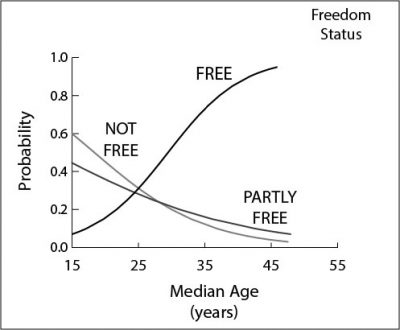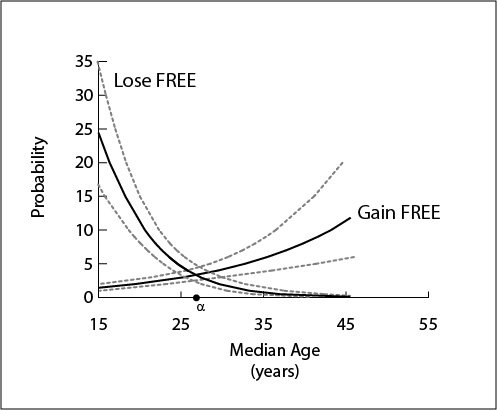The Age-structural Model of Liberal Democracy [excerpted from Cincotta, R. 2015. “Who’s Next? Age Structure and the Prospects of Democracy and Conflict in North Africa and the Middle East.” in Population Change in Europe, the Middle-East and North Africa: Beyond the Demographic Divide, edited by K.N. Koenraad Matthijs, Christiane Timmerman, Jacques Haers, and Sara Mels. (Farnham, UK: Ashgate, 167-202)]. Also see: Cincotta, R. 2015. “Demography as Early Warning: Gauging Future Political Transitions in the Age-structural Time Domain.” Journal of Intelligence Analysis 22(2):129-148; Cincotta, R. “Will Tunisia’s Democracy Survive? A View from Political Demography“.

Fig. 1. The relationship between median age (i.e., age-structural maturity) and the probability of being assessed as FREE by Freedom House. Estimates for PARTLY FREE and NOT FREE are shown as well.
Getting beyond a median age of 25 years clearly appears as a milestone for a modern state—and getting past 30 seems even better. At anytime over the past four decades, about half of all countries at a median age of 29 years have been assessed as FREE (i.e., median age 29 is known as FREE50). For countries that attain an intermediate age structure, approximately a third of the boost in liberal democracy can be credited to the “age-structural timing” of their ascent to liberal democracy, the other two-thirds are due to the increased stability as a liberal democracy (Fig. 1). For states in which the population has entered the mature phase of the age-structural transition, the next older category, around 9 out of 10 states (87.8 +2.7 percent) have been assessed as FREE.
Nonetheless, some states achieve FREE before reaching a median age of 25 years. These youthful democracies typically risk losing FREE (becoming PARTLY FREE or NOT FREE) within a decade (Fig. 2). Since these data were first generated, until now (2016), 62 states have dropped from FREE to another status. To date, only four of those losses have been above the crossing point of the two curves (point Alpha, Fig. 2): Thailand, Ukraine, Latvia and Estonia (the latter two recovered FREE within a year).

Fig. 2. The probabilities of gaining FREE and losing FREE at different points in the age-structural transition (measured by median age).
However, states can sometimes behave “more youthfully” than they mathematically appear. The persistence of significantly large, politically organized, youthful minorities in states with otherwise intermediate or mature populations appears to inhibit the ascent and stability of liberal democracy. The driver of this inhibition can take the form of political and civil discrimination against minorities or restrictions on civil liberties that are associated with ongoing intra-state conflict or post-conflict situations—the youthful minority being the focal point of conflict (examples include Sri Lanka during and after the 1983-2009 civil war, and Turkey’s conflict to the Kurdish southeast).
So far, getting “demographically older” has been good for democracy. It remains to be seen, however, whether this dictum will hold true for the European and East Asian states that are poised to advance, during the next two decades, into the post-mature phase of the age-structural transition. It would not be surprising if liberal democracies with post-mature populations were to experience difficulties maintaining their Free status. Advanced aging sets the stage for numerous plausible catalysts for such a retreat, including: rollbacks in the provision of vital services due to state indebtedness; social and political tensions between indigenous populations and more youthful migrants (where applicable); and ideological tensions over taxation and its allocation.
References
Cincotta, Richard P., and John Doces. “The Age-Structural Maturity Thesis: The Youth Bulge’s Influence on the Advent and Stability of Liberal Democracy.” In Political Demography: How Population Changes Are Reshaping International Security and National Politics, edited by Jack A. Goldstone, Eric Kaufmann and Monica Duffy Toft, 98-116. Basingstoke and New York: Palgrave-MacMillan, 2011. The steep slope of this relationship was initially studied with a linear model; for that work, see: Cincotta, R.P. 2008/09. “Half a Chance: Youth Bulges and Transitions to Liberal Democracy.” Environmental Change and Security Program Report 13:10-18 (this paper includes the 2008 prediction of liberal democracy in North Africa).
